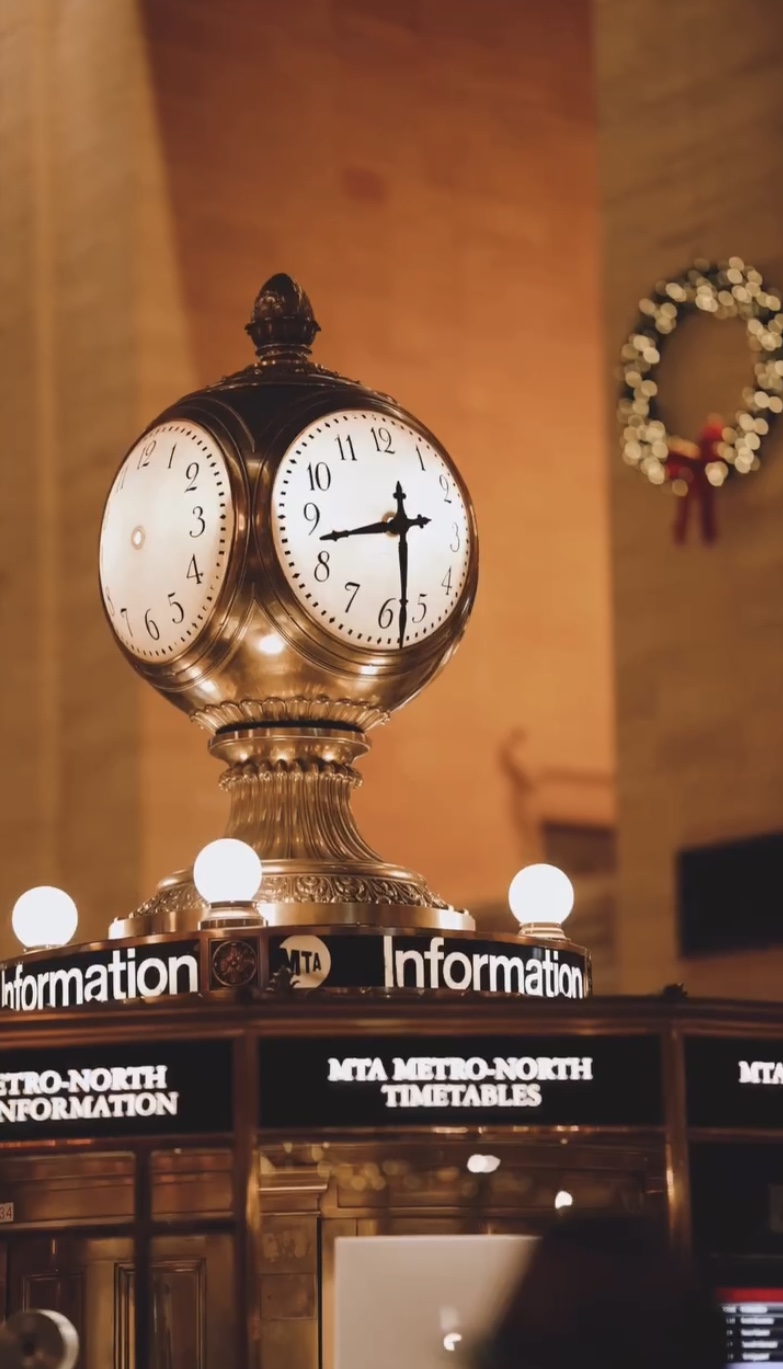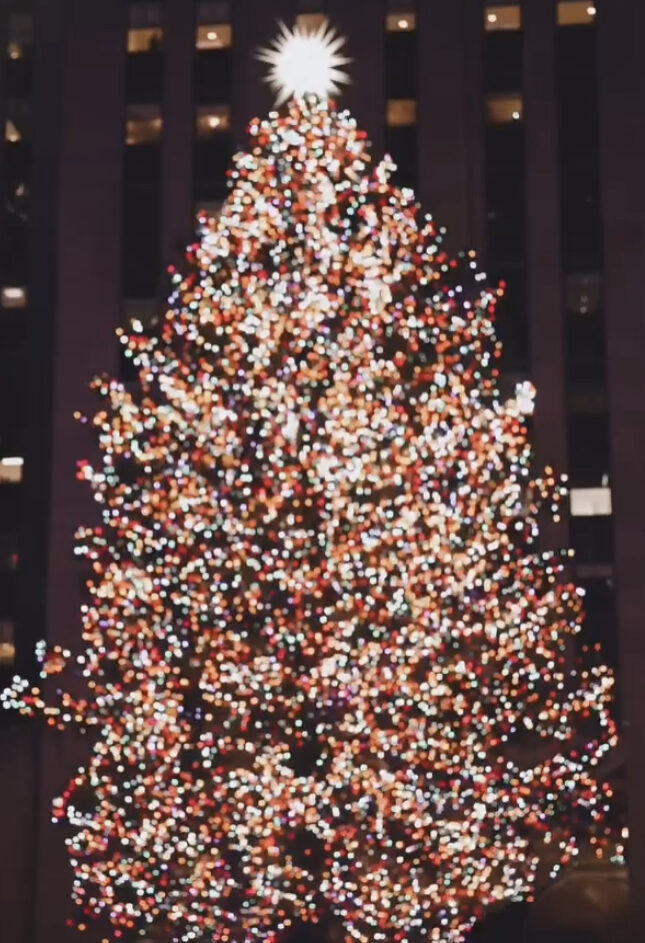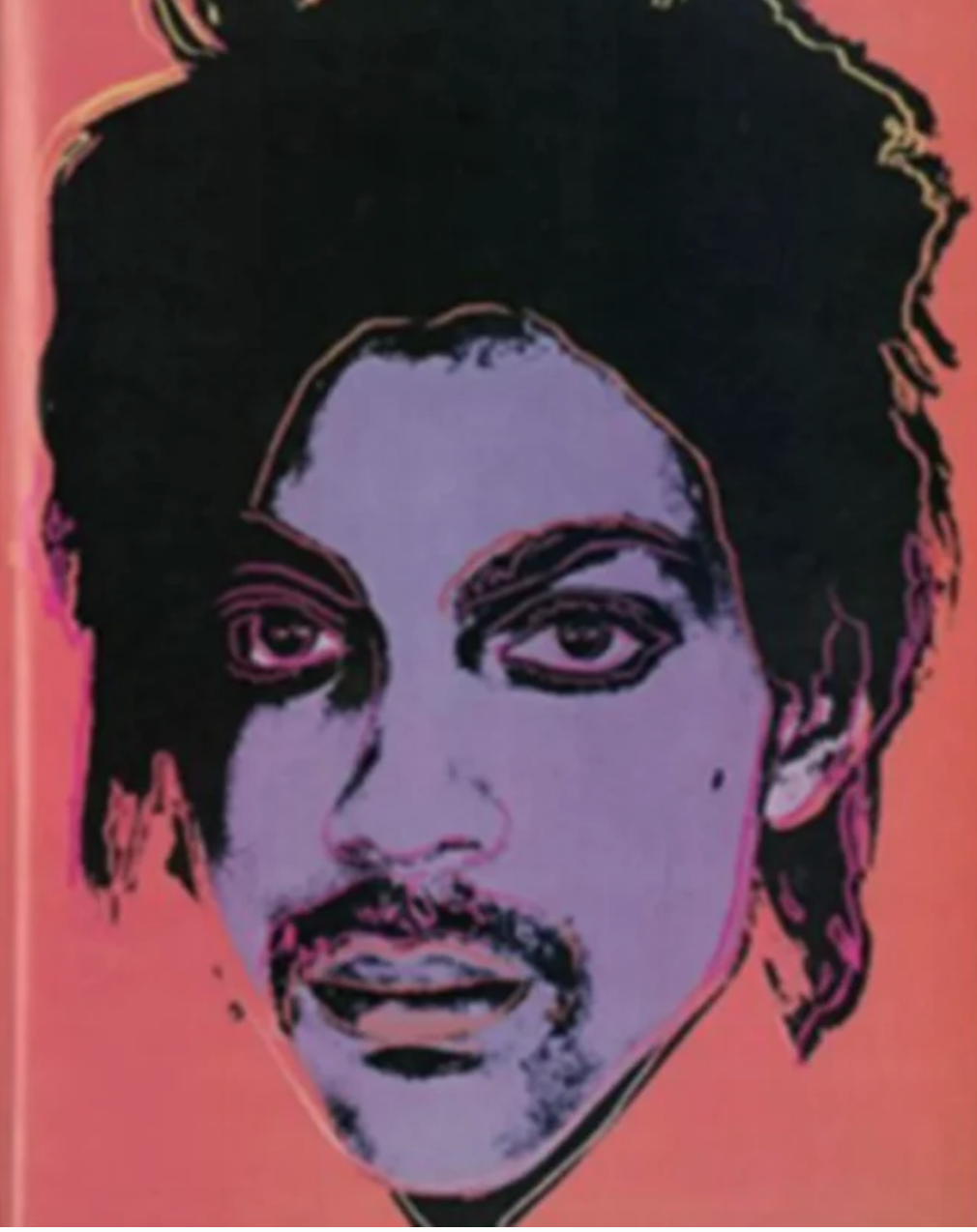by Amineddoleh & Associates LLC | Dec 10, 2023 |
In our annual holiday newsletter, Amineddoleh & Associates is pleased to share some of the major developments that took place at our firm and in the art market during 2023. We had a banner year, as we were grateful to work with many returning clients, as well as new ones, including museums, collectors, galleries, artists, and entrepreneurs. We are pleased to share some holiday JOY from us to you.

Grand Central Station. Image courtesy of NannFilms, used with permission.
CLIENTS AND REPRESENTATIVE MATTERS
Hiroshi Sugimoto’s Point of Infinity
Our firm proudly announced the public art unveiling of our esteemed client Hiroshi Sugimoto’s Point of Infinity. The gravity-defying sculpture maintains an optical illusion that the two points of the work will (eventually, even if only in the viewer’s minds’ eye) meet. It is a testament to the genius of Sugimoto as an artistic force. Read more here.
Client Acquires Master Drawings in New York
We proudly represented our client Christopher Bishop and his eponymous Christopher Bishop Fine Art in the acquisition of the art fair Master Drawings in New York. The fair, held annually in January in New York City, focuses on works on paper and features several important galleries, as well as programs with leading institutions. Interested in attending the 2024 event? Mark your calendars for opening day on January 27th. Read more here.
Client Opens New Gallery Space
Our firm was pleased to work with Atamian-Hovsepian Curatorial Practice as it transitioned from freelance curating to unveiling its own inaugural gallery and exhibition space in New York City, focusing on underrepresented artists.
Antiquities Restitutions
Amineddoleh & Associates was involved in a number of cultural heritage restitutions this year, including the return of a valuable marble statue to its country of origin and the return of a collection of historic artifacts to their home overseas.

Snow-covered cabin. Artwork courtesy of Justin Leitner, used with permission.
ART & IP NEWS
One thing we love about the art market is that there is always something unexpected and exciting happening in the art world. Read on for a glimpse at some of our most popular blog posts this past year.
Commercialism v. Transformativeness
In this blog post, our firm examined shifts in copyright law following the decision in Andy Warhol Foundation for the Visual Arts, Inc. v. Goldsmith, et al. This highly-anticipated Supreme Court decision involved application of the fair use test (a test used to determine whether the use of a copyrighted work may be used without permission) to a case with peculiar facts: a photographer (Goldsmith) provided a limited license through Vanity Fair that allowed another artist (Warhol) to use her photograph to create a silkscreen work. Warhol violated the terms of the license, and trouble ensued. Legal scholars hoped that the decision would provide clarification on the test. Unfortunately, the high court’s opinion did not provide much guidance. Curious as to why? Read more here.
Wise Women in Art & Entrepreneurship
Ever wonder where all the great women artists were in your art history lectures? At Amineddoleh & Assoc., we did, too. In honor of International Women’s Day, our firm took a closer look at some of the most talented and undercelebrated women artists in history. We also highlighted our friends at Building 180 – a standout, full-service global art production and consulting agency filling the gap between artists and businesses to create public and private art installations. Read more on our website.
Armenian Cultural Heritage at Risk
Our firm took an exclusive look at the Armenian cultural heritage at risk due to aggression from the Azerbaijani regime. The exodus of Armenians and Azerbaijan’s occupation of Artsakh left Armenian art and architecture unprotected. Artsakh is known as the “Crown Jewel” of Armenian cultural heritage, as it contains some of the most exemplary representations of medieval Armenian architecture, as well as important sites such as the first school to teach the Armenian alphabet in the early fifth century. Also in this post, our firm highlighted the new legal pathway the Republic of Armenia paved when seeking assistance from international courts to help protect their treasures. Read more here.

Christmas ornaments on 6th Ave. Image courtesy of NannFilms, used with permission.
LAW FIRM UPDATES AND EVENTS
Firm Founder Listed Again by Chambers
For the second consecutive year, firm founder Leila A. Amineddoleh was recognized by Chambers and Partners High Net Worth Guide for her work in Art and Cultural Property Law. The publication named Leila as an attorney who has “a lot of expertise in the cultural property space,” with “a great courtroom manner.” The publication also remarked on her active presence in the art law space and her work in the litigation area. Read more here. Leila was also named one of the “Top 10 Most Influential Art and Cultural Property Law Lawyers in 2023” by Business Today. For that award, Leila was selected for her “unique touch of fervor to her work, combined with a comprehensive understanding of art law.” Read more about that award here.
Art Law Conferences
Congratulations to our firm’s founder Leila A. Amineddoleh, who successfully chaired the 15th Annual NYCLA Art Law Institute, one of the most anticipated events of the year. Leila also moderated a fascinating panel during the event entitled “Broken Promises: Promised Gifts and Legal Enforceability.” A major theme in the panel was for lawyers to be extremely aware of the time between the time the gift was made, and the time the gift is executed (word to the wise: things can change!).
Yelena Ambartsumian gave a presentation at the conference with Claudia Quinones, one of our former associates (and current friend). The two gave thoughtful insight and wisdom on issues surrounding title and authenticity.

Santa Con NYC in Central Park. Image courtesy of Nycmstar, used with permission.
IN THE PRESS
Leila appeared in the Washington Post and in an article for ABC News this year, in addition to other notable publications. In each, she was consulted as an expert voice on a variety of art and cultural heritage law topics, including discussions on the ethical implications of resolving cultural antiquities ownership disputes.
Additionally, Leila was invited to contribute to the Third Edition of The Art Law Review. Her article, “Cultural Heritage Disputes and Restitution” examines Nazi-looted art disputes, antiquities litigations, government seizures, and ethical concerns related to the acquisition and display of Colonial-era takings. Read more here. Another of Leila’s scholarly publications, “Kings, Treasures, and Looting: The Evolution of Sovereign Immunity and the Foreign Sovereign Immunities Act,” was published in the Columbia Journal of Law & the Arts. Read more here.

Christmas tree at Rockefeller Center. Image courtesy of NannFilms, used with permission.
Leila also was featured in New York Metro Super Lawyers Magazine as a leader in her field. For the article, Leila’s was highlighted as an exemplary, top-rated intellectual property, art, and cultural heritage lawyer well-known in the industry for getting the job done right. Read more here. Leila was also the feature story in Boston College Magazine’s Winter 2023 issue. The story followed Leila’s art law career along with the story of the looted marble bust that was restituted to Germany in 2022. Read more here.
Maria T. Cannon contributed several letters to the Wall Street Journal this past year on AI and the ethical implications of attorneys and artists. She was also published in the ABA’s Art & Cultural Heritage Law Newsletter, Spring 2023 Edition. You can read it here. She also presented two lectures this past year. The first was in Asheville, NC, about the challenges attorneys face when dealing with celebrity-inspired art. Read more here. The second was at Cardinal Gibbons High School on Nazi-looted art. Finally, she completed Artificial Intelligence Governance Professional training through internationally-recognized leader in privacy, information, and cybersecurity law, IAPP.

White birch forest. Artwork courtesy of Justin Leitner, used with permission.
On behalf of Amineddoleh & Associates, we wish you a happy and healthy holiday season and a wonderful and prosperous new year.
P.S. Click here for one last special holiday message from our firm!
by Amineddoleh & Associates LLC | Oct 26, 2023 |
Congratulations to our firm’s founder, Leila Amineddoleh, who successfully chaired the 15th Annual NYCLA Art Law Institute: New Insights in Art Law. This annual conference is one of the most highly-anticipated and innovative events of the year.

Peak fall foliage in NYC’s Central Park, just in time for the Conference. Image via Central Park Conservatory.
This year’s was no exception. The two-day event highlighted leading experts and voices in the our industry. Read below to get a glimpse of how panelists dove into the hottest topics facing artists and lawyers today – they dove into a wide array of topics, including evolving issues in the art market, art and cultural heritage law, and intellectual property.
New Developments, Dispute Resolution, & Art World Conflicts of Interest
Day 1 opened with a smash-hit panel. The panel, featuring Paul Cossu, Adrienne R. Fields, and Claudia Quinones, tackled new developments in art law and intellectual property. One highlight from this panel was the intersection of AI-created art and copyright law. A takeaway was that the U.S. Copyright Office tends to make decisions related to AI-created art based on whether AI was used merely as a tool, or whether AI was the true author.
Next, Gabrielle C. Wilson moderated a fascinating panel on resolving art disputes. The panel pondered the critical considerations and alternatives when resolving art disputes. This panel presented attendees with multiple, practical paths to use when dealing with these controversies. In some situations, art attorneys may find greater success by encouraging negotiation between parties, rather than pursuing litigation. As a whole, this second panel was a good reminder for art lawyers to continue to lean on their specific expertise in the art world to help both side achieve a just and equitable solution.
Finally, Katherine Wilson-Milne moderated a panel on art world conflicts of interest. The panel explored ways to approach these conflicts, including some suggestions for innovative paths forward. This panel encouraged participants to broaden their perception as to where art world conflicts may come from in subsequent years. With so many aspects of the cultural, financial, and political climate in flux, the art industry is being directly and indirectly impacted. It is essential for attorneys to be aware of new developments in art world conflicts of interest, and ways to best address them as they arise.
Title and Authenticity, Broken Promises, & Artist Residences
Day 2 narrowed the Conference’s focus even more precisely. The day started off with our firm’s own Yelena Ambartsumian’s presentation with Claudia Quinones. The two gave thoughtful insight and wisdom on issues surrounding title and authenticity. One highlight from Claudia’s portion included the latest developments in Nazi-looted artwork. She drew attention to the most essential cases to watch in the coming months, and provided great detail as to the specific laws at issue in each case.
Yelena then dove into powerful issues regarding cultural heritage. She brought specific attention to Armenian cultural heritage, and the current risk for destruction of such treasures. Yelena also explained the legal paths the Republic of Armenia has taken to protect their cultural heritage, due to a lack of UNESCO involvement. She also gave phenomenal insight into the hot top of authenticity issues. One takeaway from that aspect of her presentation is that, if there are reasons to be skeptical about the authenticity of a work of art, it is a good idea for the attorney to explore those suspicions!
Next up, our founder Leila moderated a fascinating panel on the enforceability of promised gifts and what happens when circumstances change. The length of time between the time the gift was made, and the time the gift is executed, was a major theme in this panel. The panel also parsed through the diverse scenarios that arise when receiving monetary gifts versus physical collections of art. In terms of physical artwork, the cost of conservation was also highlighted as an important factor in whether or not a museum or institution is even able to properly receive a certain gift. This point is especially poignant in the industry’s current climate, as costs of conservation continue to rise alongside other financial needs of leading institutions.
Melissa Passman wrapped up the day by moderating the final panel of the Conference. This closing panel explored artist residence issues, and how to navigate founder and participant relationships. One takeaway was that the resources made available to artists in these relationships tend to drive the residency as a whole. As a result, it’s important for attorneys involved to be aware of the specialized spaces and studios that may be necessary. Otherwise, it would be impossible for the artists to work and fulfill the terms of their residencies. Another takeaway was that tax laws tend to dictate what non-profit organizations are able to accomplish in these relationships. Because this could complicate artist payment in residencies, it is necessary for lawyers working with these clients to be well-aware of tax obligations, and to make that a driving factor in negotiating agreements.
Another great year!
In all, attendees experienced two action-packed days of practical advice and innovative guidance. Our firm commends all of the presenters for their hard work and fascinating presentations. We look forward to this conference each year, and this year’s was truly a celebration of the best, boldest, and brightest minds in our ever-evolving field.
Let the record stand that peak fall foliage in Central Park has its perks, but the real highlight of October in NYC is the Annual Art Law Institute.
P.S. Missed the Conference? Get in touch with NYCLA here to purchase the recording when it is released.
by Amineddoleh & Associates LLC | May 25, 2023 |
Last week, the U.S. Supreme Court released its highly anticipated decision in Andy Warhol Foundation for the Visual Arts, Inc. v. Goldsmith et al. Art law and intellectual property law attorneys and scholars had been anxiously awaiting the decision, in hopes it would provide some guidance for the application of the fair use test (a test used to determine whether the use of a copyrighted work may be used without permission). For a background on other recent copyright matters, as well as a look at the lower court decisions in AWF v. Goldsmith, read this earlier journal article or the array of articles written about this long-fought battle.
Unfortunately, the high court’s opinion has not provided much clarification. One problem is that the facts here are peculiar, involving a photographer (Goldsmith) who provided a limited license through Vanity Fair that allowed another artist (Warhol) to use her photograph to create a silkscreen work. Unfortunately, Andy Warhol violated the terms of the license, and then decades later his foundation (AWF) sold one of the violating works (“Orange Prince”) to Condé Nast (Vanity Fair’s parent corporation). Condé Nast had licensed the photograph from Goldsmith. In essence, both Goldsmith and AWF were licensing their works to the same publisher (Goldsmith’s license was $400 while AWF charged $10,000). As such, the unusual facts lead to an unusual application of copyright law, not providing helpful guidance (except for the fact that artists should abide by the terms of their licenses).
FACTUAL BACKGROUND

The original Lynn Goldsmith photograph of the artist. Image by Lynn Goldsmith.
As the court aptly noted, the litigation is a dispute between two artists. One of the artists (Warhol) is well known internationally, perhaps one of the best-known artists of the 20th century. The other (Goldsmith) is a trailblazing female photographer, although not a household name. The court’s decision noted that Goldsmith was a rock photographer at a time that the field was dominated by men, and that Goldsmith had “few female peers.” Although not enjoying the same level of fame as Warhol, Goldsmith was an artist in her own right. And while Warhol received a license to use Goldsmith’s photograph of Prince for a single use, he violated the terms and created an additional fifteen works without paying any additional fees. Decades later, the photographer learned of the misuse and informed AWF of the infringement. Rather than seeking a resolution with the spurned artist, AWF sued Goldsmith, filing a declaratory judgment of noninfringement, or alternatively, fair use.
The Southern District of New York granted summary judgment for AWF, finding there was fair use because all four factors of the fair use test (described below) favored AWF. The Second Circuit reversed, finding that all four factors actually weighed in favor of Goldsmith. AWF applied to the US Supreme Court for certiorari, which was granted. The only question before the Supreme Court was whether the first fair use factor, “the purpose and character of the use, including whether such use is of a commercial nature or is for nonprofit educational purposes,” §107(1), weighs in favor of AWF. On that narrow issue, the Supreme Court agreed with the Second Circuit: the first factor favors Goldsmith.
THE FAIR USE ANALYSIS
Fair use is an exception to copyright protection allowing someone to use a copyrighted work without receiving permission from the copyright holder. Fair use has generally been applied to uses for criticism, comment, news reporting, teaching, scholarship, and research. In determining, courts apply a four-factor analysis outlined in Section 107 of the 1976 Copyright Act:
“(1) purpose and character of the use, including whether such use is of a commercial nature or is for nonprofit educational purposes; (2) the nature of the copyrighted work; (3) the amount and substantiality of the portion used in relation to the copyrighted work as a whole; (4) the effect of the use upon the potential market for or value of the copyrighted work.” (17 U.S.C. §107.)
The challenge is that the fair use analysis involves subjective judgments, making some copyright determinations inconsistent.
LEGAL ANALYSIS IN ANDY WARHOL FOUNDATION V. GOLDSMITH

Andy Warhol’s image of the artist. Image via Andy Warhol Foundation for the Visual Arts.
In authoring the majority and dissenting opinions, the justices take off their gloves and grapple with the challenges inherent in the analysis of copyright law, balancing the benefits of incentivizing artists while not overly restricting followers to build off earlier artists. (One of our favorite jabs appears in Footnote 10, when the majority writes, “the dissent begins with a sleight of hand.”) But this goes to demonstrate the difficulty in making a ruling in this dispute. Fair use determinations have always been fraught with uncertainty, especially when relating to artists pushing the envelope, with appropriation artists creating particularly challenging scenarios.
Here, the justices had difficulty reviewing the first prong of the fair uses test. The majority ultimately balanced the degree of difference in character of the works (transformativeness) with other considerations, like commercialism. The Supreme Court dialed back the importance of “transformativeness” in the fair use analysis. A decade earlier, the Second Circuit Court of Appeals indicated that the most important factor in a fair use analysis is transformativeness. Essentially, in Prince v. Cariou, the Second Circuit made transformative use the primary test of fair use, allowing that consideration to outweigh the other factors in the four-part test. The decision was shocking at the time, providing more protection to appropriation artists, but leaving fewer options for those seeking the more traditional protections under copyright law.
Unlike the Second Circuit in Prince v. Cariou, the Supreme Court noted that the fair use test is a 4-factor balancing test, with transformativeness itself not enough to justify fair use. The Court remarked that “‘transformative use’ would swallow the copyright owner’s exclusive right to prepare derivative works…” The majority opinion also noted that Warhol’s silkscreen did not comment on Goldsmith’s photograph (commenting on the photo itself would likely be parody and considered a fair use), but rather, Warhol used the photo simply because it was helpful in the creation of the secondary silkscreen work. This was not enough to allow fair use because Goldsmith’s photo and Warhol’s silkscreen had similar commercial uses, illustrating a magazine story on Prince.
The Court instructs that fair use must balance between original and secondary works based in part on the purpose and character of use, including whether it is commercial and why there was copying. The Court warns that Goldsmith’s works are entitled to copyright protection, “even against famous artists.” As such, the Court held that it would be beneficial to require AWF to pay Goldsmith a fraction of the proceeds from its reuse of her copyrighted work, in part because these payments are incentives for artists to create original works.
The concurrence (authored by Gorsuch and joined by Jackson) agrees that the undisputed facts demonstrate that AWF used the silkscreen image as a commercial substitute for Goldsmith’s photograph.
THE FIERY DISSENT
The majority’s opinion is somewhat defensive while the dissent is fiery and oozes with art historical references. The majority jabs the dissenters by accurately (and painfully) stating, “The Lives of the Artists undoubtedly makes for livelier reading than the U. S. Code or the U. S. Reports, but as a court, we do not have that luxury.” However, the dissent seemingly enjoys this opportunity to reference art, music, and literature to argue that artists have always copied others.
Kagan’s dissent is artful and insightful with its impassioned pleas and fear for the future of the art world. She argues that the case “will stifle creativity of every sort. It will impede new art and music and literature. It will thwart the expression of new ideas and the attainment of new knowledge. It will make our world poorer.” It is true that art history is full of creators building upon the work of others, and there is some fear that the holding in this case could stifle creativity, especially with appropriation art. However, the Court’s finding here is not a bar against appropriation art, but rather a decision deeming it unfair when the commercial purpose is so closely aligned between the original and secondary works.
The Copyright Act was passed to provide an author with a bundle of rights that includes the right to reproduce the work and create derivative works. This is balanced by the fair use test (17 U. S. C. §107), a 4-factor balancing test, that allows artists access to the use of an underlying work, under certain circumstances. But the fair use analysis does not allow other creators a free-for-all. (It’s also important to note once again that Goldsmith did not only rely on the Copyright Act to protect her rights, but she also negotiated and contracted to provide Warhol with a limited license to create one image. It is reasonable to assume that Andy Warhol could have complied with the terms of his license or paid an additional fee for the use of Goldsmith’s photographic works.)
It should also be acknowledged that Goldsmith did not initiate this lengthy legal battle. When she confronted AWF, the Foundation could have addressed the issue with the photographer, rather than filing for declaratory judgment.
At the end of the day, the Supreme Court itself struggled in the battle between transformativeness versus commercialism, something that has long faced judges in applying the fair use analysis.
by Amineddoleh & Associates LLC | Mar 14, 2022 |
As practitioners working in the art and intellectual property realm, our team remains apprised of developments in these areas. Of course it is also a pleasure to publish articles on art and IP law topics for practitioners and others interested in these areas. Leila’s recent article for the Institute of Art & Law examines recent developments in copyright law. The landscape of copyright law has recently gone through unexpected developments with a number of cases that have left some artists uneasy about the Fair Use Exception and the use of copyrighted materials in appropriation art. Please contact the Institute of Art & Law for a copy of Leila’s informative article.
by Amineddoleh & Associates LLC | Dec 6, 2021 |
Last month our founder was honored to present a 3-hour lecture on the topic of NFTs and collectibles for the EXECUTIVE MASTER IN ART MARKET STUDIES the University of Zurich. During her lecture, she spoke about a high-profile litigation involving NFTs (a discussion of the case follows). Amineddoleh & Associates LLC had been at the forefront of the NFT market, working with platforms (including Nifty Gateway), automated contract providers (Monax), and minters, artists, and collectors.
As the popularity of NFTs continues to grow, legal questions and controversies have arisen in this emerging field. Several of these disputes concern artists’ rights over the minted material that is being sold, sometimes without their knowledge or consent. However, in other cases, copyright holders (who are not the creators of the source material) are alleging infringement and filing suit to prevent the sale and distribution of NFTs.

Copyright: Miramax
A recent case involves celebrated director Quentin Tarantino. Early last month, he announced he seven secret NFTs of uncut, exclusive scenes from his cult film, Pulp Fiction. The film, released in 1994, was written and directed by Tarantino, produced by Lawrence Bender and starred Hollywood heavyweights John Travolta, Samuel L. Jackson, and Uma Thurman. It was Miramax’s first release after being acquired by Disney and it was completely financed by Miramax. Since its release, Pulp Fiction has earned critical acclaim. It has grossed over $213 million worldwide and Tarantino won an Academy Award for Best Original Screenplay. The highly-anticipated Pulp Fiction NFT collection will consist of seven tokens, each of which will be a single, iconic scene “from the never-before-seen, handwritten screenplay” and will contain “personalized audio commentary” from Tarantino. The NFT announcement prompted Miramax to SUE Tarantino in California for breach of contract, as well as copyright and trademark infringement.
Pulp Fiction Secret NFTs
As part of the sale process for Mr. Tarantino’s NFTs, a WEBSITE HAS BEEN CREATED which provides information about secret NFTs generally and the Pulp Fiction series. The website also offers access to an interest form and waiting list, along with instructions on how to buy the NFTs. It explains that the NFTs are part of a new asset class, called secret NFTs. Secret NFTs have enhanced privacy and access controls and live on the Secret Network. This means that the “owner will enjoy the freedom of choosing between: 1. Keeping the secrets to themselves for all eternity. 2. Sharing the secrets with a few trusted loved ones. 3. Sharing the secrets publicly with the world.”
Miramax’s Legal Arguments

Miramax bringing out the “big guns”
Copyright: Miramax
Shortly after Tarantino’s announcement, Miramax served him with a CEASE-AND-DESIST LETTER on November 4. According to Miramax, Mr. Tarantino’s plan to sell “intensified and expanded” when @TarantinoNFTs tweeted that the Pulp Fiction NFTs will include scans of pages from Pulp Fiction script and the Artifacts Collection of iconic props from Mr. Tarantino’s major films including “one from Pulp Fiction.”
On November 16, Miramax filed a lawsuit against Tarantino in the U.S. District Court for the Central District of California. The complaint alleges breach of contract, copyright infringement, trademark infringement, and unfair competition. Miramax claims that Tarantino’s limited contractual rights over Pulp Fiction, which include interactive games, live performances, and other ancillary media, exclude NFTs linked to the screenplay. Tarantino has the right to publish portions of the screenplay, but the proposed sale of original pages or scenes in NFT format could be considered a one-time transaction rather than a publication. Moreover, the company argues that Tarantino’s use of Pulp Fiction branding and imagery will confuse buyers into thinking that the NFTs are official Miramax products. However, this has not deterred Tarantino from proceeding with the upcoming sale.
Miramax is seeking a jury trial, unspecified monetary damages, and injunctive relief, aiming to stop planned December sale, as well as frustrate any of Tarantino’s future efforts infringing on what Miramax believes to be its rights to Pulp Fiction. The company is concerned that if Tarantino prevails, this will set a PRECEDENT for other creators to “exploit Miramax films through NFTs and other emerging technologies, when in fact Miramax holds the rights for these films.” The effects of a ruling in favor of Tarantino could spill over to other film companies, placing them in direct competition with creators. For example, when a company releases and sells NFTs related to a film (as in the case of Space Jam: A New Legacy during July 2021), those profits may need to be shared.
The complaint outlined that Tarantino was subject to several agreements limiting his rights to reproduce certain content related to Pulp Fiction. This included a Rights Agreement between Tarantino, Bender, and Miramax, a transfer of rights agreement between Tarantino and B25 Productions with Miramax’s consent, an assignment agreement for the benefit of Miramax, as well as several other agreements.
Under these agreements, Miramax states that they were granted:
“all rights (including all copyrights and trademarks) in and to the Film (and all elements thereof in all stages of development and production) now or hereafter known including without limitation the right to distribute the Film in all media now or hereafter known (theatrical, non-theatrical, all forms of television, home video, etc.).”
However, the contracts also reserve rights to Tarantino, including: “soundtrack album, music publishing, live performance, print publication (including without limitation screenplay publication, ‘making of’ books, comic books and novelization, in audio and electronic formats as well, as applicable), interactive media, theatrical and television sequel and remake rights, and television series and spinoff rights.”
Given the rights granted to each party, Miramax believes that Tarantino is in breach of contract, as well as infringing on Miramax’s copyrights. The question turns on whether these NFTs are covered by the rights reserved by Tarantino.
In the complaint, Miramax distinguishes the language used to grant each party their rights. It characterizes Tarantino’s reserved right as a “narrowly-drafted, static exception to Miramax’s broad, catch-all rights” and “do[es] not contain any forward-looking language.” By contrast, the language used to describe Miramax’s rights is labeled as broad and forward looking. It grants Miramax “all rights . . . now or hereafter known . . . in all media now or hereafter known”.
Regardless of the specific forward-looking language in the contracts, the rights do not specifically address NFTs. Over three decades ago, the parties to the agreements did not contemplate the existence of NFTs. Thus, this gives either party arguments as to why the rights in the contracts may or may not allow the sale of these NFTs.
Tarantino’s Legal Argument

Image from Warhol Foundation v. Goldsmith litigation
Tarantino’s counsel stated in an email to Miramax that he and his client believe that the NFTs are covered under Tarantino’s reserved “print publication” or “screenplay publication” right. Under copyright law, a small distribution of a protected good, to a limited pool is not considered a “publication” and the complaint argues Tarantino’s proposed sale is of a “few original script pages or scenes” and an NFT is only a “one-time transaction.” However, given the novelty of NFTs, it is unclear whether a court would consider them a “publication.” But, since NFTs can be openly shared and produced, this may undermine Miramax’s argument.
Another legal defense that may be available to Tarantino is the Fair Use Doctrine. This allows courts to “avoid the rigid application of the Copyright Act when such application would stifle the very creativity the law was designed to foster” and can be used as an affirmative defense in copyright and trademark infringement cases. Under this doctrine, criticism, commentary, news reporting, teaching, scholarship, or research are listed as purposes for which the use of copyrighted work may be considered fair.A court may also find that the use is fair if the work is deemed transformative.
To determine fair use, courts balance four considerations: (1) the purpose and character of the use; (2) the nature of the copyrighted work; (3) the amount and substantiality of the portion used; and (4) the effect of the use upon the potential market for the copyrighted work. Cariou v. Prince, 714 F.3d 694, 705 (2d Cir. 2013). Transformative use must “communicat[e] something new and different from the original or expan[d] its utility.” Authors Guild v. Google, Inc., 804 F.3d 202, 214 (2d Cir. 2015). Simply transposing a work from one medium to another does not necessarily qualify as transformative fair use. See Andy Warhol Foundation for the Visual Arts, Inc. v. Goldsmith, 992 F.3d 99 (2021).
It is clear that NFTs are creating a new art market and reconfiguring conceptions of copyright for intangible assets. In the sale of NFTs, the Fair Use Doctrine may protect against constant copyright lawsuits. While some NFTs are parodies or commentaries on popular culture or other well-known images or videos, the Pulp Fiction NFTs are directly related to the product for which Miramax holds the copyrights. However, unlike other NFTs, Tarantino is building on and adding to the copyrighted work. By adding commentary and exclusive material, he is arguably “transforming” the stills encapsulated in the NFT series.
A work used for commercial activity, as compared to non-commercial activity, generally weighs against a finding of fair use. Tarantino’s NFT website states that he is selling the Pulp Fiction NFTs because he “is enamored with Pulp Fiction, a timeless creation, and as such wanted to give the public a new glimpse into the iconic scenes from the screenplay of the film.” Further, the website notes that Tarantino sees himself “as an artist” and these NFTs explore “new, exciting mediums to express his artistic style and ideas.” This suggests that he believes that these NFTs are his artistic expression that builds on this cult classic.
However, it could also be argued that Tarantino’s use of the copyrighted material falls within the scope of commercial use, if one considers the broader NFT market. There is a very large value that could be derived from the sale of these NFTs. The fact that people have been selling NFTs for a monetary benefit may suggest that Tarantino’s sale is commercial and it will weigh against his fair use defense. In terms of financial gain, one of Miramax’s attorneys stated that: “This one-off effort devalues the NFT rights to Pulp Fiction, which Miramax intends to maximize through a strategic, comprehensive approach.” In the company’s opinion, the NFTs are considered economic, rather than artistic, assets and Tarantino has deprived Miramax of this revenue stream.
Nonetheless, it could also be argued that the NFTs are not “simply transposing a work from one medium to another,” which supports Tarantino’s fair use defense. The NFTs will include scenes from the Miramax’s copyrighted material, but they will also include “personalized audio commentary from Quentin Tarantino”. Commentary on major scenes in a critically acclaimed movie from the man that wrote and directed the film is certainly a way of adding to the existing material in a way that could be considered transformative when compared to the original.
As the purpose of the Fair Use Doctrine states, intellectual property laws exist to allow freedom of expression. While Tarantino may have entered into a contractual agreement with Miramax, and Miramax may hold copyrights “to the Film (and all elements thereof in all stages of development and production)” as well as to the “right to distribute the Film in all media now or hereafter known (theatrical, non-theatrical, all forms of television, home video, etc.),” Tarantino is arguably creating new content and is entitled to benefit from his artistic output.
Conclusion
As the NFT market continues to boom, many lawyers are considering novel legal arguments related to digital assets, especially in connection with copyright laws. Miramax v. Pulp Fiction is a lawsuit that is receiving and will continue to attract attention. Both sides have arguments and legal theories in their respective favor. It will certainly be interesting to follow the court’s analysis as it considers this landmark controversy, which will likely serve as a model for future claims, both in and beyond the entertainment industry. It is also possible that new regulations or guidelines will be created to address the specific legal issued posed by NFTs, given the volatility of the crypto market and increased scrutiny by legislators.
It is important for both creators and copyright holders interested in making, buying, and selling NFTs to be aware of their remedies and consult legal professionals where appropriate. Read more on NFTs and the work carried out by Amineddoleh & Associates in this field, INCLUDING a cutting-edge template agreement for Monax, on our BLOG.











